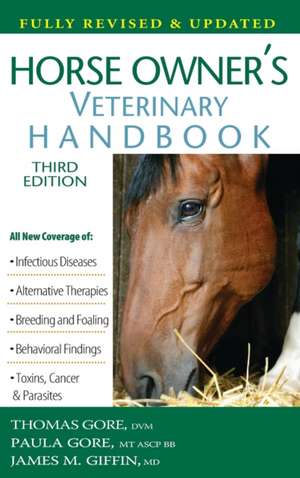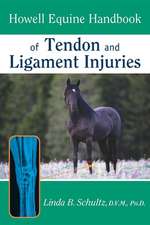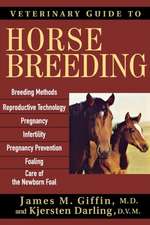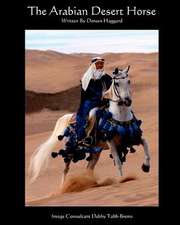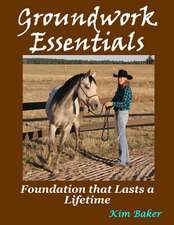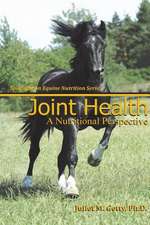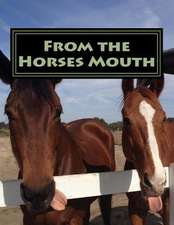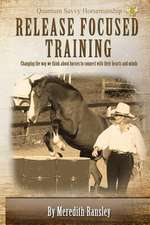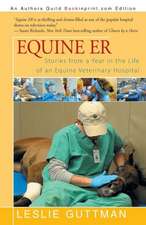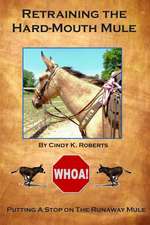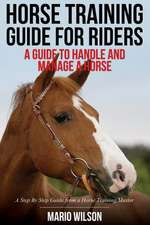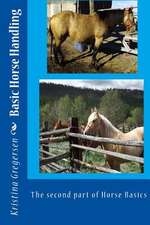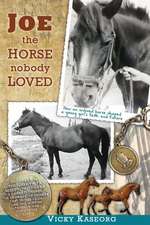Horse Owner's Veterinary Handbook
Autor Tom Gore, Paul A. Gore, James M. Giffinen Limba Engleză Hardback – 3 iul 2008
Preț: 325.48 lei
Nou
Puncte Express: 488
Preț estimativ în valută:
62.29€ • 64.78$ • 52.13£
62.29€ • 64.78$ • 52.13£
Carte disponibilă
Livrare economică 22 februarie-08 martie
Preluare comenzi: 021 569.72.76
Specificații
ISBN-13: 9780470126790
ISBN-10: 0470126795
Pagini: 692
Dimensiuni: 165 x 231 x 51 mm
Greutate: 1.18 kg
Ediția:Revised, Update
Editura: Howell (TP)
Locul publicării:Hoboken, United States
ISBN-10: 0470126795
Pagini: 692
Dimensiuni: 165 x 231 x 51 mm
Greutate: 1.18 kg
Ediția:Revised, Update
Editura: Howell (TP)
Locul publicării:Hoboken, United States
Descriere
A fully updated edition of the classic equine health reference an indispensable guide for every horse owner Chock–full of information, the latest edition of the trusted classic is organized to allow you to find what you need with confidence and ease.
- A special Index of Signs and Symptoms is on the inside of the front cover for fast referral. Consult this if your horse exhibits any symptoms or unexplained behavior.
- A detailed Contents list outlines the organs and body systems that are the sites of disease.
- A General Index gives you a comprehensive guide to the book′s medical information. Bolded page numbers help you identify more detailed coverage of the subject.
- Cross–references note pertinent supplementary information.
- A Glossary defines medical terms that are commonly used by veterinarians.
- As a bonus, go online to find additional references on: sample reference values for laboratory tests, and guides to antibiotics, antifungals, antiprotozoals, and common drugs your veterinarian might prescribe.
Textul de pe ultima copertă
A fully updated edition of the classic equine health reference an indispensable guide for every horse owner Chock–full of information, the latest edition of the trusted classic is organized to allow you to find what you need with confidence and ease.
- A special Index of Signs and Symptoms is on the inside of the front cover for fast referral. Consult this if your horse exhibits any symptoms or unexplained behavior.
- A detailed Contents list outlines the organs and body systems that are the sites of disease.
- A General Index gives you a comprehensive guide to the book′s medical information. Bolded page numbers help you identify more detailed coverage of the subject.
- Cross–references note pertinent supplementary information.
- A Glossary defines medical terms that are commonly used by veterinarians.
- As a bonus, go online to find additional references on: sample reference values for laboratory tests, and guides to antibiotics, antifungals, antiprotozoals, and common drugs your veterinarian might prescribe.
Cuprins
Introduction. Chapter 1: EMERGENCIES.
Handling and Restraint.
Abdominal Pain (Colic).
Burns.
Cardiovascular Collapse.
Dehydration.
Electric Shock.
Exertional Myopathy (The Tying–Up Syndrome and Azoturia).
Heat Stroke.
Insect Stings, Spiders, and Scorpions.
Poisoning.
Shock.
Snake and Lizard Bites.
Sudden Unexplained Death.
Chapter 2: PARASITES.
Internal Parasites (Worms).
Controlling Internal Parasites.
External Parasites.
Controlling External Parasites.
Chapter 3: INFECTIOUS DISEASES.
Bacterial Diseases.
Viral Diseases.
Rickettsial Diseases.
Systemic Fungal Diseases.
Protozoan Diseases.
Antibodies and Immunity.
Vaccinations.
Chapter 4: THE SKIN AND COAT.
How to Avoid Coat and Skin Problems.
Sorting Out Skin Problems.
Abnormal Sweating.
Allergies.
Pyoderma.
Fungus Infections.
Seborrhea.
Environmental and Traumatic Skin Disorders.
Tumors and Cancers.
Chapter 5: THE EYES.
Field of Vision.
The Eye Exam.
If Your Horse Has an Eye Problem.
The Eyelids.
Foreign Bodies and Chemicals in the Eye.
The Outer Eye.
The Eyeball.
The Tearing Mechanism.
The Cornea.
The Inner Eye.
The Blind Horse .
Chapter 6: THE EARS.
Ear Care.
The Pinna.
The Ear Canal.
The Middle and Inner Ear.
Chapter 7: THE MOUTH.
Signs of Mouth Problems.
Problems in the Mouth.
The Teeth.
Taking Care of Your Horse s Teeth.
Dental Problems.
Chapter 8: THE FEET.
The Laminae.
The Elastic Tissues.
The Hoof as a Shock Absorber.
Hoof Care.
Putting on Horseshoes.
Natural Hoof Care.
Foot Wounds and Injuries.
Foot and Hoof Diseases.
Navicular Disease.
Laminitis (Founder).
Equine Metabolic Syndrome.
Chapter 9: THE MUSCULOSKELETAL SYSTEM.
Conformation and Soundness.
Lameness.
Tendon Injuries.
Bursitis.
Joint and Ligament Injuries.
Periostitis.
Developmental Orthopedic Diseases.
Arthritis.
Broken Bones.
Muscle Injuries and Diseases.
Chapter 10: THE RESPIRATORY SYSTEM.
Nasopharyngeal Endoscopy.
Signs of Nasal Irritation.
The Nasopharynx.
The Guttural Pouches.
The Soft Palate and Epiglottis.
The Throat.
The Larynx.
The Lower Respiratory System.
Chapter 11: THE CARDIOVASCULAR SYSTEM.
Evaluating the Circulation.
Arrhythmias.
Congestive Heart Failure.
Cardiovascular Disease.
Vascular Diseases.
Anemia.
Equine Blood Types.
Chapter 12: THE URINARY SYSTEM.
Signs of Urinary Tract Disease.
Diagnosing Urinary Tract Diseases.
Urinary Tract Infections.
Paralyzed Bladder.
Uroliths (Urinary Tract Stones).
Kidney Failure.
Kidney Diseases.
Chapter 13: THE NERVOUS SYSTEM.
The Neurological Examination.
Cranial Nerve Paralysis.
Peripheral Nerve Injuries.
Head Trauma.
Spinal Cord Problems.
Brain and Spinal Cord Infections.
Seizures.
Chapter 14: THE DIGESTIVE SYSTEM.
The Esophagus.
The Stomach.
Peritonitis.
The Small Intestines.
Intestinal Obstructions.
Colic.
The Liver.
The Rectum and Anus.
Constipation.
Diarrhea.
Chapter 15: NUTRITION AND FEEDING.
Nutritional Requirements.
Feedstuffs.
How to Feed Your Horse.
Weight Gain and Loss.
Wood Chewing and Cribbing.
Forage Toxicities.
Chapter 16: SEX AND REPRODUCTION.
The Mare.
The Estrous (Heat) Cycle.
Abnormal Heat Cycles.
Preparing the Mare for Breeding.
The Stallion.
Genetic Testing.
Breeding.
Twins.
Infertility in the Mare.
Assisted Reproduction Techniques.
Infertility in the Stallion.
Sexually Transmitted Diseases.
Diseases of the Female Reproductive System.
Diseases of the Male Reproductive System.
Preventing Heat.
Preventing Pregnancy.
Chapter 17: PREGNANCY AND FOALING.
Care and Feeding During Pregnancy.
Fetal Loss.
Life–Threatening Complications of Pregnancy.
Preparing for Foaling.
Normal Labor and Delivery.
After the Delivery.
Imprinting.
Dystocia (Prolonged Labor).
Postpartum Problems.
Lactation.
Chapter 18: PEDIATRICS.
Feeding for the First Year.
Preventive Medicine.
Diseases of the Foal.
Congenital Disorders.
Chapter 19: GERIATRICS.
Physical Changes.
Behavioral Changes.
Equine Cushing s Disease.
Caring for the Geriatric Horse.
Managing Chronic Pain.
Euthanasia.
Chapter 20: DRUGS AND MEDICATIONS.
Anesthetics and Tranquilizers.
Anti–Inflammatory Drugs and Analgesics.
Antibiotics.
How to Give Medications.
Chapter 21: ALTERNATIVE THERAPIES.
Nutraceuticals.
Herbal Medicine.
Homeopathy.
Manual Therapies.
Acupuncture.
Appendix A: NORMAL PHYSIOLOGICAL DATA.
Appendix B: LABORATORY TESTS.
Glossary.
About The Authors.
List of Tables.
Index.
Handling and Restraint.
Abdominal Pain (Colic).
Burns.
Cardiovascular Collapse.
Dehydration.
Electric Shock.
Exertional Myopathy (The Tying–Up Syndrome and Azoturia).
Heat Stroke.
Insect Stings, Spiders, and Scorpions.
Poisoning.
Shock.
Snake and Lizard Bites.
Sudden Unexplained Death.
Chapter 2: PARASITES.
Internal Parasites (Worms).
Controlling Internal Parasites.
External Parasites.
Controlling External Parasites.
Chapter 3: INFECTIOUS DISEASES.
Bacterial Diseases.
Viral Diseases.
Rickettsial Diseases.
Systemic Fungal Diseases.
Protozoan Diseases.
Antibodies and Immunity.
Vaccinations.
Chapter 4: THE SKIN AND COAT.
How to Avoid Coat and Skin Problems.
Sorting Out Skin Problems.
Abnormal Sweating.
Allergies.
Pyoderma.
Fungus Infections.
Seborrhea.
Environmental and Traumatic Skin Disorders.
Tumors and Cancers.
Chapter 5: THE EYES.
Field of Vision.
The Eye Exam.
If Your Horse Has an Eye Problem.
The Eyelids.
Foreign Bodies and Chemicals in the Eye.
The Outer Eye.
The Eyeball.
The Tearing Mechanism.
The Cornea.
The Inner Eye.
The Blind Horse .
Chapter 6: THE EARS.
Ear Care.
The Pinna.
The Ear Canal.
The Middle and Inner Ear.
Chapter 7: THE MOUTH.
Signs of Mouth Problems.
Problems in the Mouth.
The Teeth.
Taking Care of Your Horse s Teeth.
Dental Problems.
Chapter 8: THE FEET.
The Laminae.
The Elastic Tissues.
The Hoof as a Shock Absorber.
Hoof Care.
Putting on Horseshoes.
Natural Hoof Care.
Foot Wounds and Injuries.
Foot and Hoof Diseases.
Navicular Disease.
Laminitis (Founder).
Equine Metabolic Syndrome.
Chapter 9: THE MUSCULOSKELETAL SYSTEM.
Conformation and Soundness.
Lameness.
Tendon Injuries.
Bursitis.
Joint and Ligament Injuries.
Periostitis.
Developmental Orthopedic Diseases.
Arthritis.
Broken Bones.
Muscle Injuries and Diseases.
Chapter 10: THE RESPIRATORY SYSTEM.
Nasopharyngeal Endoscopy.
Signs of Nasal Irritation.
The Nasopharynx.
The Guttural Pouches.
The Soft Palate and Epiglottis.
The Throat.
The Larynx.
The Lower Respiratory System.
Chapter 11: THE CARDIOVASCULAR SYSTEM.
Evaluating the Circulation.
Arrhythmias.
Congestive Heart Failure.
Cardiovascular Disease.
Vascular Diseases.
Anemia.
Equine Blood Types.
Chapter 12: THE URINARY SYSTEM.
Signs of Urinary Tract Disease.
Diagnosing Urinary Tract Diseases.
Urinary Tract Infections.
Paralyzed Bladder.
Uroliths (Urinary Tract Stones).
Kidney Failure.
Kidney Diseases.
Chapter 13: THE NERVOUS SYSTEM.
The Neurological Examination.
Cranial Nerve Paralysis.
Peripheral Nerve Injuries.
Head Trauma.
Spinal Cord Problems.
Brain and Spinal Cord Infections.
Seizures.
Chapter 14: THE DIGESTIVE SYSTEM.
The Esophagus.
The Stomach.
Peritonitis.
The Small Intestines.
Intestinal Obstructions.
Colic.
The Liver.
The Rectum and Anus.
Constipation.
Diarrhea.
Chapter 15: NUTRITION AND FEEDING.
Nutritional Requirements.
Feedstuffs.
How to Feed Your Horse.
Weight Gain and Loss.
Wood Chewing and Cribbing.
Forage Toxicities.
Chapter 16: SEX AND REPRODUCTION.
The Mare.
The Estrous (Heat) Cycle.
Abnormal Heat Cycles.
Preparing the Mare for Breeding.
The Stallion.
Genetic Testing.
Breeding.
Twins.
Infertility in the Mare.
Assisted Reproduction Techniques.
Infertility in the Stallion.
Sexually Transmitted Diseases.
Diseases of the Female Reproductive System.
Diseases of the Male Reproductive System.
Preventing Heat.
Preventing Pregnancy.
Chapter 17: PREGNANCY AND FOALING.
Care and Feeding During Pregnancy.
Fetal Loss.
Life–Threatening Complications of Pregnancy.
Preparing for Foaling.
Normal Labor and Delivery.
After the Delivery.
Imprinting.
Dystocia (Prolonged Labor).
Postpartum Problems.
Lactation.
Chapter 18: PEDIATRICS.
Feeding for the First Year.
Preventive Medicine.
Diseases of the Foal.
Congenital Disorders.
Chapter 19: GERIATRICS.
Physical Changes.
Behavioral Changes.
Equine Cushing s Disease.
Caring for the Geriatric Horse.
Managing Chronic Pain.
Euthanasia.
Chapter 20: DRUGS AND MEDICATIONS.
Anesthetics and Tranquilizers.
Anti–Inflammatory Drugs and Analgesics.
Antibiotics.
How to Give Medications.
Chapter 21: ALTERNATIVE THERAPIES.
Nutraceuticals.
Herbal Medicine.
Homeopathy.
Manual Therapies.
Acupuncture.
Appendix A: NORMAL PHYSIOLOGICAL DATA.
Appendix B: LABORATORY TESTS.
Glossary.
About The Authors.
List of Tables.
Index.
Notă biografică
Thomas Gore, DVM, has been practicing veterinary medicine for over thirty years. Growing up on a cattle ranch in the mountains of western Colorado, he has been caring for, and caring about, horses all his life. Paula Gore, MT ASCP, began training colts when she was fifteen years old. Her equine experiences include racetrack work, an Arabian breeding facility, showing in both English and Western disciplines, competing in team penning, and cattle work.
